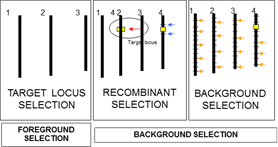Authors: Prasenjit Debnath And Anirudha Kumar Sahu
Sr. M.Sc.(Agri.), Dept. of Biotechnology, UAS, Dharwad, Karnataka, PIN-580005
Correspondence mail id: prasenjitdebnath2@gmail.com
Introduction
A rising global population requires increased crop production and some research suggests that the rate of increase in crop yields is currently declining and traits related to yield, stability and sustainability should be a major focus of plant breeding efforts. Different crops, which faces lots of problems (biotic and abiotic) during cultivation. Which ultimately effects the yields. Modern biotechnological tools were used to improve crop varieties against these stresses. These traits include durable disease resistance, abiotic stress tolerance and nutrient and water use efficiency. Now a days molecular breeding is an emerging tool to develop plant varieties against stress. Appling marker assisted backcross breeding is an artistic tool to develop varieties within a short span of time which is nearly impossible to get a plant variety through conventional breeding approach within a short period. Plant varieties which are produced through MABB don’t go through any type of regulation like transgenic crops.
Marker-assisted backcrossing is the simplest form of MAS, in which the goal is to incorporate a major gene from an agronomically inferior source into an elite cultivar or breeding line.
Advantage of Marker Assisted Backcross Breeding:-
• Selection can be carried out at the seedling stage.
• It is simpler than phenotypic screening which can save time, resources and efforts.
• Single desire plants can be selected.
• It can save time.
Marker assisted selection having three strategies
1. Foreground selection:- Marker assisted foreground selection approach is performed in the backcross population to track the target alleles. In foreground selection, the breeder selects plants having the marker allele of the donor parent at the target locus. The objective of this type of selection is to maintain the target locus in a heterozygous state (one donor allele and one recurrent parent allele) until the final backcross is completed. Tightly linked markers are used to perform foreground selection. Foreground selection is compulsory in every generation.
2. Recombinant Selection:- The purpose of recombinant selection is to reduce the size of the donor chromosome segment containing the target locus (i.e. size of the introgression). This is important because the rate of decrease of donor fragment is slower than for unlinked regions and many undesirable genes that negatively affect crop performance may be linked to the target gene from the donor parent, this is referred to as ‘linkage drag’ (Hospital, 2005). Flanking markers are used in this step to find out the plants having short donner segment.

Collard et al., 2008
3.Background Selection:- Selecting back cross progeny with the greatest proportion of recurrent parent genome, using markers that are unlinked to the target locus we refer to this as ‘background selection’. In this step scientists used large number of unliked markers randomly distributed in all the linkage group of the target crop to track the background recovery.
ACTIVITIES OF MABB
Marker-assisted breeding involves following steps-
• Planting the breeding populations.
• Identification of markers for polymorphism survey.
• Sampling plant tissues, usually at early stages of growth.
• Extracting DNA from the tissue sample of each individual and preparing DNA samples for PCR and marker screening.
• Running PCR with appropriate markers to identify the target plants.
• Selecting the best individuals/families with both desired marker alleles for target traits and desirable performance/phenotypes of other traits, by jointly using marker results and other selection criteria.
• Repeating the above activities for several generations
Some examples of successful MABB programmes
| Crop varities | Trait | Country | Year | Institute |
| Pusa RH10 | BLB | India | 2010 | IARI |
| Pusa Sugandh5 | Blast | India | 2012 | IARI |
| Improved Sambha Mahsuri | BLB | India | 2008 | DRR |
References:
1. Collard, B. C. Y. and Mackill, D. J., 2008, Marker assisted selection: an approach for precision plant breeding in the twenty first century. Phil. Trans. R. Soc. B., 363: 557-572.
2. Collard, B. C. Y., Jahufer, M. Z. Z.,Brouwer, J. B. and Pang, E. C. K., 2005, An introduction to markers, quantitative trait loci (QTL) mapping and marker assisted selection for crop improvement: The basic concepts. Euphytica, 142: 169-196.
3. Hospital, F., 2001, Size of donor chromosome segments around introgressed loci and reduction of linkage drag in marker-assisted backcross programs. Genetics,
158: 1363-1379.
4. Marker assisted Plant breeding-Principles and practices by B. D. Singh and A. K. Singh.
About Author / Additional Info: